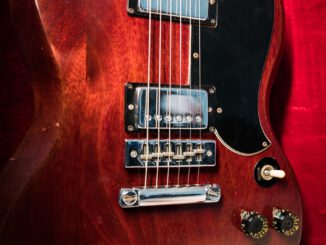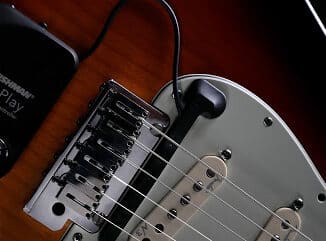
Its status in the six-string universe is legendary, but Gibson guitar corporation has never made a real impact in the bass-guitar market. Since the Sixties, Gibson has developed and marketed basses that, for one reason or another, just didn’t catch on. Although they were an alternative attempt to Fender’s popular basses, Gibson’s four-string were plagued by limited tonal range, top heavy, and baseball bat-like necks.
Of course, there were a few Gibson models that contributed greatly to the history of rock and roll: the EB-3 bass used by Jack Bruce (Cream) and Free’s Andy Fraser, and Gene Simmons’ notorious Gibson LPB BassRipper bass. But, for the most part, Gibson basses had a limited appeal. However, with the introduction of the entire line of 4-and 5-string Les Paul basses, Gibson’s stature in the rock-bottom market stands an excellent chance of changing for the better.
When designing the Les Paul Bass, Gibson use the woods responsible for the classic sound of the Les Paul guitar: mahogany and maple. Balancing the rich, warm tone of the mahogany neck and body with the clearly defined highs of maple by the top, the LPB Les Paul bass possesses a tonal diversity much like that of its six-string predecessor. However, Gibson has departed from its traditional use of a rosewood fingerboard, using ebony instead. The order would give the bass extended brightness.
The first and most crucial test of any bass is to hear how it sounds unplugged. After playing just a few notes on the LPB, I felt the instrument’s warmth and resonance buzz through my hands and up my arms. I took the bass through its paces, playing a number of styles; it sounded and felt great on everything from slap to playing with a pick. A bass that sounds this good without an amp couldn’t fail to please when plugged in.
Due to the absence of a rear-body contour, the LPB looks as if it may be uncomfortable to play. Surprisingly, the bass sat perfectly in both sitting in standing positions, with none of the top-heavy-ness of Gibson’s older basses. The 20-fret, 34-inch scale, glued-joint neck meets the body at the 17th fret, and the uppermost notes are easily accessed through a lower-body cutaway. For those who like the feel of a thin neck, Gibson’s exclusive thin taper design (1.625 inches at the nut) allows for easy, comfortable playing. The fretwork and neck finish on the review model were extremely smooth and almost flawless, except for a small amount of glue which had leaked from the fingerboard/neck joint. This unsightly goo yielded no perceivable negative effects on playability or tone.
The LPB possesses a perfect electronic system for the practical/working bassist—sufficient for maximum playability, but not too complex as to be confusing on stage. A simple control layout (volume, bass, treble and pickup blend) coaxes a myriad of tonal variations from the Bartolini TCT active circuitry and two Bartolini humbucker pickups: thunderous lows, controllable highs and a wide midrange. Even with all the settings on flat, the LPB sounded great. I played the bass in a number of different gigging situations and only had to make a few eq adjustments—this instrument truly speaks. And while the blend control doesn’t allow for both pickups to be full-open simultaneously (it can only be set to 50-50, 60-40, etc.), it does offer a wide range of sonic possibilities. The nine-volt battery that powers the TCT on-board preamp rests in a fully shielded rear-body cavity, and I found all the soldering connections to be spotless.
All the LPB’s hardware (including the traditional Gibson “speed” knobs) are exclusive to Gibson. A three-way adjustment bridge (string height, length and spacing) offers easy adjustments to players who prefer to vary their string spacing, but the bass was good to go right out of the box—no tweaking was needed to fix action or intonation. The LPB stayed consistently in tune through a number of live performances and some extremely aggressive playing.—discontinued Product.
Les Paul 1915 – 2009 R.I.P



![Höfner 456 Vintage Guitar Market 500/1 [The Beatles Bass] 4 Paul McCartney Guitar](https://gear-vault.com/wp-content/uploads/2011/06/paul.mccartney.jpg)

erm bit confused…..the pic show a selector switch ,but no mention of it, so that must be 2 vol and 2 tone on the pic ?
Yes, the selector switch is on the upper-bout. 2 volume, 2 tone on the Les Paul Bass guitar.